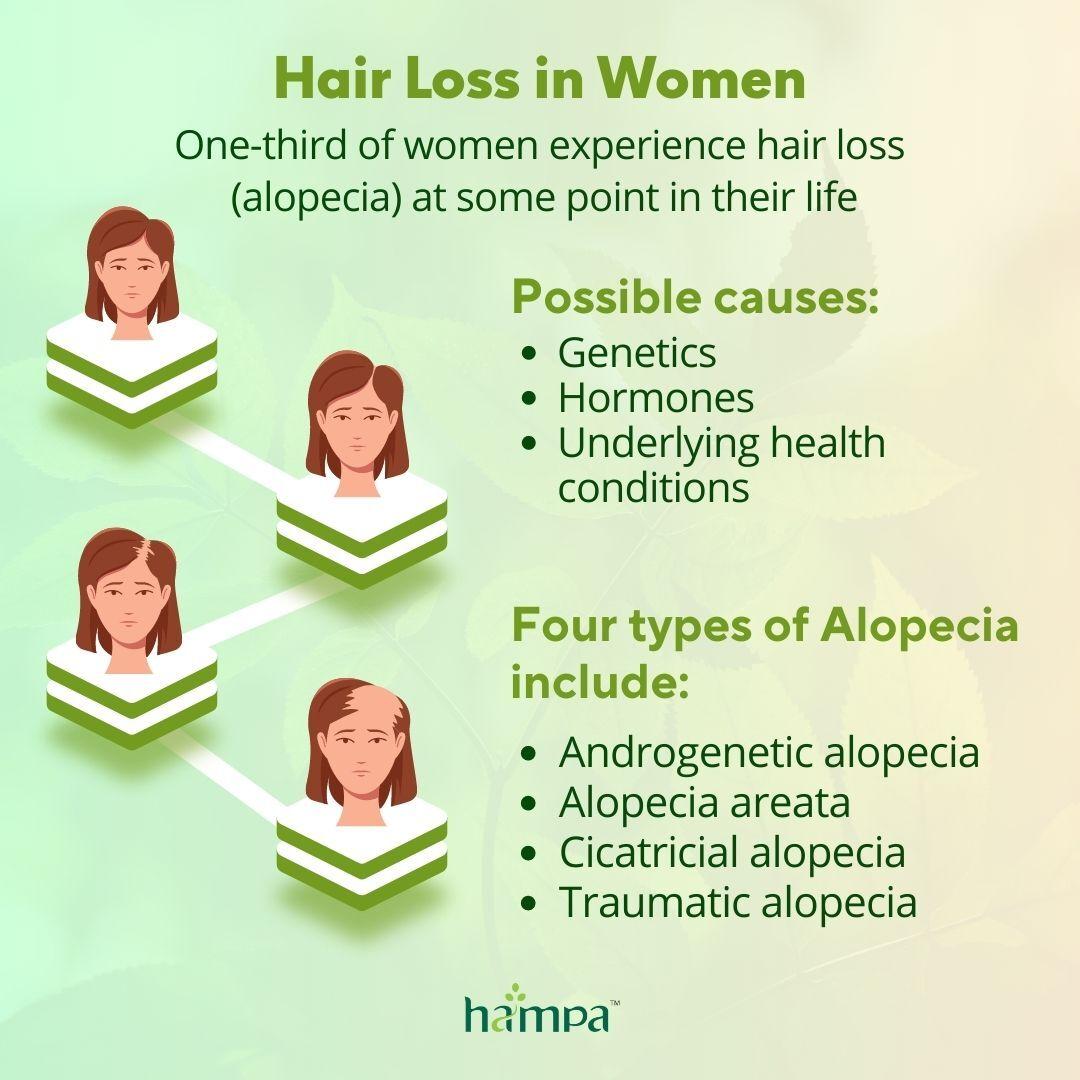
One-third of women experience hair loss (alopecia) at some point in their life. As many as two-thirds of postmenopausal women have hair thinning or bald spots. Women's hair loss often has a more significant impact than men's hair loss because it is less socially acceptable for them. Alopecia can harm a woman's emotional well-being and quality of life.
The most common cause of hair loss in women is the same as in males. Androgenetic alopecia, or female (or male) pattern hair loss, is the medical term for this condition. Hair loss in men typically begins above the temples, with the receding hairline forming a distinctive "M" shape; the hair on the top of the head also thins, often leading to baldness. Androgenetic alopecia manifests in women as gradual thinning at the portion line, followed by increasing diffuse hair loss from the top of the head. Women's hairlines rarely recede, and they rarely go bald.
Possible causes
A few different factors that contribute to female pattern baldness can include:
- Genetics: This condition is hereditary, and you can inherit the gene for pattern baldness from either parent.
- Hormones: Female pattern baldness commonly begins after menopause, though it can also occur during pregnancy.
- Underlying health conditions: An underlying endocrine condition or hormone-secreting tumour can also cause female pattern baldness.
Patterns of Hair Loss in Women:
Clinicians use the Ludwig Classification to describe female pattern hair loss. Type I thinning is mild and can be concealed with hair styling techniques. Type II is distinguished by reduced volume and a notable expansion of the mid-line section. Type III describes diffuse thinning on the top of the scalp with a see-through appearance.
Almost every woman will have some degree of female pattern hair loss at some point in her life. It can begin after puberty, although women usually notice it around menopause when hair loss often rises. The risk increases with age, and it is more significant in women with a history of hair loss on either side of the family.
The life cycle of hair:
Each hair grows from a follicle, a small pocket in the skin, and passes through three stages of development. The active growth phase, the anagen (A), lasts two to seven years. The transition phase, Catagen (B), lasts around two weeks. The hair shaft rises upwards towards the skin's surface during this phase, and the dermal papilla (the structure that nourishes the cells that give rise to hair) begins to split from the follicle. Telogen (C), the resting phase, lasts about three months and results in hair shaft shedding.
A clinician diagnoses female pattern hair loss after collecting a medical history and inspecting the scalp. They will examine the pattern of hair loss, look for symptoms of inflammation or infection, and may conduct blood tests to rule out other potential reasons for hair loss, such as hyperthyroidism, hypothyroidism, and iron deficiency. A hormonal assessment is typically unneeded unless there is evidence of increased androgen activity (such as monthly abnormalities, acne, and undesirable hair growth).
Androgenetic alopecia:
Androgenetic alopecia is a form of hair loss due to increased androgen activity. It can be inherited and involve multiple genes or be caused by an underlying endocrine disorder, such as androgen overproduction or an androgen-secreting tumour. It affects both sexes by shortening the hair's growing phase and lengthening the period between losing and regrowing hair. This causes hair to become thinner and more delicate over time.
Four types of alopecia include:
- Androgenetic alopecia is female pattern baldness or hair loss caused by genetics, and it is more common in women and can begin gradually after puberty. Men tend to notice balding as a receding hairline and specific bald spots, while hair loss in women appears more as overall thinning.
- Alopecia areata causes sudden patchy hair loss on the head or body. It typically starts with one or more round bald patches that may overlap.
- Cicatricial alopecia is a group of irreversible hair loss conditions that cause scarring. The hair falls out, and the follicle is replaced with scar tissue.
- Traumatic alopecia results from hair styling damage. Using hot combs, blow dryers, straighteners, or chemicals for dying or straightening the hair may damage and break the hair shaft, causing hair fall.
To know more about Hampa products that can tackle hair loss, visit https://hampawellness.in/collections/hair-care
Hampa = Wholesome Nutrition. All Hampa products use Hemp and other natural ingredients to heal and rejuvenate to achieve our brand mission of bringing you a variety of hemp-based personal care, therapeutic, and nutritional health products that are sustainably sourced and scientifically supported.

